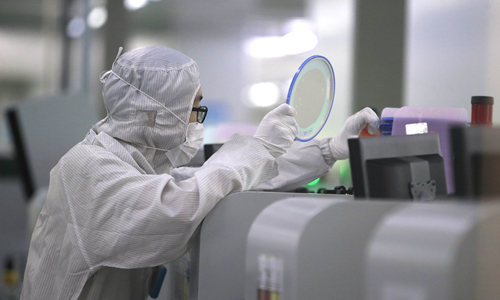SOURCE / INDUSTRIES
Microchips import to exceed $300 billion in 2020: semiconductor expert

Workers of HC Semitek, a leading Chinese LED chip maker, produce chips at its subsidiary in Yiwu in East China's Zhejiang Province. (Photo: Yang Hui/GT)
China's microchips import is expected to reach more than $300 billion for the third consecutive year, Wei Shaojun, deputy director general at China Semiconductor Industry Association, said at the World Semiconductor Conference 2020 in Nanjing, East China's Jiangsu Province Wednesday.
Despite the US' relentless crackdown on China's leading technology enterprises, the process of localizing China's semiconductor sector is gathering pace thanks to the central government's favorable policies to bolster the semiconductor industry.
Opportunities lie in difficulties. On one hand, the coronavirus has slowed down overall chips demand; on the other, China's semiconductor industry is accelerating its localization rates due to US government' restrictive measures, Wei said. "This is a boon for China's domestic semiconductor industry, though the benefit remains limited for now."
However, Wei suggested it would be unwise for Chinese people to swarm towards the chip manufacturing sector in large numbers or to focus on the promotion of home-grown lithography machines and domestic Electronic Design Automation. "If you try to do everything by yourself, you can become isolated and start to move backwards. In addition, some technology cannot be achieved by a single country."
In 2019, China's chips import hit $304 billion, far beyond the import value of crude oil which ranked second. China aims to realize a chipset self-sufficiency rate of 70 percent by 2025, more than twice that of last year's 30 percent.
Regarding market interest in the semiconductor sector, Wei said the reaction of the secondary market was beyond expectations, but he warned the valuations of some enterprises on the science and technology innovation board ChiNext board are overvalued now.
"It is not a good phenomenon when people earn money too easily. We hope the investment in the industry will be long-term, continuous and intensive, instead of in pursuit of short-term gains," he added.
In addition, it is too early to say China's semiconductor sector has bucked the trend, according to Wei. "After the third and the fourth quarters, we would see whether China's semiconductor industry is speeding up or slowing down."
In early August, the State Council, China's cabinet, issued new rules to bolster semiconductor and software growth. The measures put forward in eight areas including taxation, investment, research and development and talent incentive, will accelerate the localization of semiconductor manufacturing in China just as industry practitioners had expected.
In addition, the European business sector hopes the bloc and China can keep a continuous and stable cooperation in areas of technological development, according to chairman of the EU Chamber of Commerce in China's Nanjing chapter Bernhard Weber.
Weber said Wednesday at the conference that further cooperation on semiconductor chips will bring benefits to both the EU and China, adding that leading European ICT enterprises are one of the largest investor groups in China.
Even though the coronavirus had brought many new challenges to the world, the new infrastructure project initiated by the Chinese government made chamber members in the ICT industry excited, he said.
According to the European Business in China Business Confidence Survey 2020 published in June, 74 percent of the respondents showed a willingness to bring the latest technology to China in order to support their sales and market expansion in China.
Global Times

